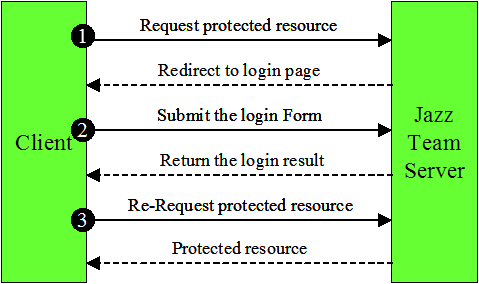This spring Steve Wasleski (Jazz Jumpstart team), Steve Speicher (OSLC and Change Management Architect) and myself built a workshop on Jazz Extensibility for Innovate 2010, the Rational Software Conference. This workshop, labs and source code, has been published on jazz.net under this link: OSLC Workshop and Jazz Extensions Workshop.
During the labs elaboration, I had to understand how the Jazz Team Server manages the authentication: Form-based Authentication and how to interact with it as a client. Because it took me some times to figure it out, I think this blog is a good place to extract this part of the lab and share it with the “Rest of the World”.
The Form-Based Authentication is a three steps process:

- The client requests a protected resource.
- If the client is not authenticated, the server redirects to the login page, and the client has to fill the form and submit it to the server.
- If the login has succeeded, the client submits a request the protected resource again and should get it back.
Clearly, the behavior doesn’t seem obvious because the process seems to indicate that it requires a human behind interaction.
Actually, you can perfectly emulate and manage this interaction programmatically.
Let say you want to reach a resource designated by a URL (protectedResource) which is protected by a Form-based authentication.
The following snippet code describes how you will implement this 3-steps process:
HttpGet documentGet = new HttpGet(protectedResource);
documentGet.addHeader("accept", mediaType);
//
// Step (1): Request the protected resource
//
HttpResponse response = httpClient.execute(documentGet);
if (response.getStatusLine().getStatusCode() == 200) {
Header header =
response.getFirstHeader("x-com-ibm-team-repository-web-auth-msg");
if ((header!=null) && ("authrequired".equals(header.getValue()))) {
response.getEntity().consumeContent();
// The server requires an authentication: Create the login form
HttpPost formPost = new HttpPost(serverURI+"/j_security_check");
List nvps = new ArrayList();
nvps.add(new BasicNameValuePair("j_username", login));
nvps.add(new BasicNameValuePair("j_password", password));
formPost.setEntity(new UrlEncodedFormEntity(nvps, HTTP.UTF_8));
//
// Step (2): The client submits the login form
//
HttpResponse formResponse = httpClient.execute(formPost);
header = formResponse.getFirstHeader("X-com-ibm-team-repository-web-auth-msg");
if ((header!=null) && ("authfailed".equals(header.getValue()))) {
// The login failed
throw new InvalidCredentialsException("Authentication failed");
} else {
// The login succeed
formResponse.getEntity().consumeContent();
//
// Step (3): Request again the protected resource
//
HttpGet documentGet2 = new HttpGet(protectedResource);
documentGet2.addHeader("accept", mediaType);
return httpClient.execute(documentGet2);
}
}
return response;
This code is based on Apache HTTP Client (Release 4.0.1) APIs.
I hope it will help.
-Philippe
43.400223
1.560553
 Regularly, the Jumpstart team members are invited to assist customers who either decided to adopt Rational Team Concert (RTC) and need to adapt their Maven build and deployment process to RTC or, as an “open source shop” wants to challenge RTC on this subject.
Regularly, the Jumpstart team members are invited to assist customers who either decided to adopt Rational Team Concert (RTC) and need to adapt their Maven build and deployment process to RTC or, as an “open source shop” wants to challenge RTC on this subject.

 They did it!
They did it!


 I recall when Paul Vanderlei invited me to join his new team, the first thing I did after his call was to
I recall when Paul Vanderlei invited me to join his new team, the first thing I did after his call was to